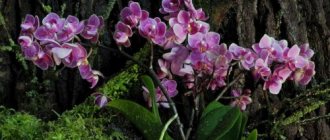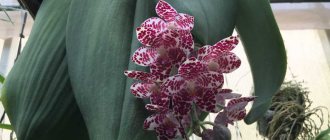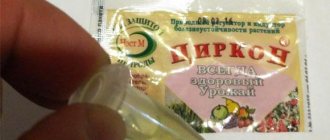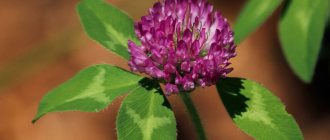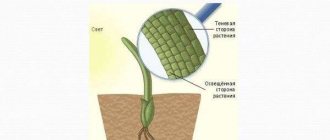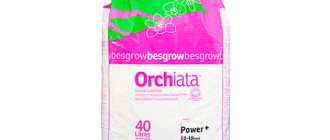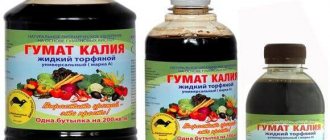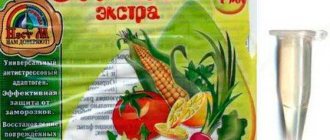A vitamin cocktail for orchids is a mix that allows the plant to better adapt to new conditions after transplantation and bloom faster and more abundantly. The only caveat is that you should not abuse such complexes, because you can harm the flower.
The main components that are included in modern fertilizers are:
- Potassium (denoted by the letter K).
- Phosphorus (denoted by the letter P).
- Nitrogen (denoted by the letter N).
Potassium is used when it is necessary to increase the vitality of a flower. Phosphorus allows you to normalize and even improve flowering. Nitrogen is responsible for green mass.
The complex composition also contains various microelements, which orchids may also lack.
The importance of vitamin supplements for plants
Regular vitamin supplementation ensures the normal course of life processes. The manifestation of healthy activity of an orchid involves :
- fast and intensive growth;
- adaptation to unstable conditions;
- complete absorption of microelements;
- complete metabolic processes based on retained moisture.
An orchid that receives sufficient nutrition develops well and produces large buds of rich color. Vitamins supply the plant with additional energy for processes associated with preparation for flowering and flowering itself.
What to consider when choosing
Vitamin complexes are not at all as harmless as they might seem at first glance. Therefore, only a doctor who knows exactly how risky it is to use a particular drug in the case of a particular patient should prescribe the right drug.
There is not always a need to take special vitamins, especially with type II diabetes. Therefore, sometimes the doctor prescribes regular vitamins, if necessary.
For example, for a woman with diabetes, a doctor may recommend vitamins for the skin, hair and nails to improve the appearance of the skin. Many vitamins are selected individually, and not in combination, because the body must always have a balance of all substances.
What additional power sources are needed?
The orchid receives the necessary nutrients from moisture and air, but there are times when the nutrition it synthesizes on its own is not enough. At this time, she requires additional sources of nutrition - vitamins:
- B1 (thiamine) activates the growth and development of the root system;
- B3 (nicotinic acid) quickly restores the flower after illness and transplantation;
- B6 (adermine) strengthens the immune system;
- B12 (cobalamin) accelerates the growth rate of the plant;
- C (ascorbic acid) strengthens the immune system, protects the orchid from ultraviolet radiation, parasites and pests.
Important! Vitamin B1 must be added strictly separately. In combination with other vitamins, it is destroyed and loses its beneficial properties.
What vitamins to use
Any nutritional mixtures, when properly formulated, are considered very effective. Vitamins are biologically active substances that have a positive effect on plant growth. They are also able to speed up the process of flower blooming without harming the orchid. The positive aspects of using such fertilizing include the fact that vitamins can have a beneficial effect on the retention of moisture in plant tissues.
However, in order for all the positive effects from using such a complex to appear, you need to select all the components correctly. Let's take a closer look at the composition of the vitamin cocktail used for indoor orchids.
B1
The second name of this component is thiamine. B1 is an important substance that any grower who grows orchids in an apartment should know about. Thiamine has the following positive effects:
- has a beneficial effect on the growth rate of the underground part of plants;
- stimulating an increase in bud size;
- stimulation of earlier flowering;
- improving the circulation of cell sap in the plant.
As you can see, the use of thiamine will greatly simplify the cultivation of this tropical beauty in your home.
B3
Another vitamin included in group B. The second name is B3 nicotinic acid. It is also a quite useful microelement for indoor orchids. Nicotinic acid makes it easier for the plant to recover after it is transferred to a new pot and substrate. When using it, the flowering period usually occurs a little earlier. In addition, B3 has a stimulating effect and can contribute to the appearance of new shoots on the flower.
B6
This is an essential component of feeding in a situation where it is necessary to protect the orchid from attacks by various parasites. B6 also has a beneficial effect on the flower’s immunity. This component should be used when the plant is frequently treated with a variety of fungicides. The vitamin is added to the soil in order to speed up the process of rooting the orchid in a new substrate during a planned transplant.
B12
The main benefit of B12 is that this vitamin has a positive effect on the production of chlorophyll in plants. At the same time, it has a good effect on the growth of flora representatives. The use of this microelement allows you to saturate the orchid with oxygen, stimulate it to form buds, as well as the formation of new flowering stems.
C
Another important component of the cocktail is vitamin C or the well-known ascorbic acid. This microelement has many beneficial properties. It has the greatest positive effect on the flower’s immune system, increasing the plant’s resistance to attacks by pests and pathogenic microflora. At the same time, ascorbic acid is also characterized by a neutralizing effect. Thanks to this, it can neutralize the harmful effects of ultraviolet rays.
Indications and contraindications
You need to feed the orchid with vitamins only when it needs it. Both excess and untimely receipt of additional nutrition can cause depression of vital functions or its death.
Indications for feeding with vitamins are the following periods and conditions of the orchid::
- autumn (lack of light and fresh air);
- loss of the root system (loss of pieces of roots);
- lack of flower appearance for a long period (up to several years);
- adaptation period after transplantation (prolonged weakening of the flower);
- general lethargy of the plant (wrinkled and curled leaves of a pale color);
- diseases (parasites and pathogenic microflora).
Contraindications for adding vitamins include the following::
- flowering period;
- dormant period (after flowering, when the plant naturally gains strength);
- good condition of the plant (dense, smooth leaves, elastic shoots, succulent flowers).
Important! A flower overfed with vitamins for prevention may die. Fertilizing is used only when absolutely necessary.
Properties and effect of succinic acid
Today, succinic acid is freely available in specialized stores that sell fertilizers and other plant care products, as well as in pharmacies. Flower growers use the substance both in pure form and as part of additives. Acid crystals dissolve well in water, ether and alcohol. To feed plants, use exclusively an aqueous solution.
Succinic acid is ideal as a means for watering orchids. This tropical flower is capricious, and if you do not create the right conditions for it, it will not bloom. Orchids especially need support after replanting and moving to a new place. Succinic acid is not used instead of fertilizers, but will help the plant absorb them better. The drug is safe and almost completely decomposes.
Treatment at home with group B additives
B1 (thiamine)
Water-soluble vitamin. Activator of plant root system growth, protection against early aging . Increases the intensity and duration of flowering. Used independently.
- Dosage: 1 ampoule 1 ml.
- Dilution: in 1 liter of water.
- Treatment: spraying once a month, during flowering.
B3 (nicotinic acid)
Accelerates the formation of flowers and sprouts . Involved in hormonal metabolism. Can be mixed with other vitamins except B1.
- Dosage: 50 mg tablet.
- Dilution: in 1 liter of water.
- Treatment: spraying 2 times a month.
B6 (adermin)
Increasing immunity, accelerating recovery from illness . Increases the adaptive properties of the plant. Combines with B3.
- Dosage: 10 mg tablet (pyridixine, pyridoxyamine, pyridoxal).
- Dilution: in a liter of water.
- Treatment: during orchid transplantation and after illness. No more than 3 times a month.
B12 (cobalamin)
Recommended during cold periods, when there is a lack of light and air . Accelerates the growth rate of orchids, affects the formation of young and maintenance of old peduncles. Combines with B3.
- Dosage: 500 mcg tablet.
- Dilution: in 1 liter of water.
- Treatment: spraying no more than 2 times a month.
Feeding methods
You can feed an orchid with vitamins in various ways. Typically, which method you choose depends on the conditions in which the orchid is located. And the effectiveness of processing depends on the method.
Therefore, to achieve the best result, the plant should be in the most comfortable conditions. Each method has its own advantages and disadvantages and is applicable in a given situation.
Spraying on leaves
Spraying is the most acceptable way to treat an orchid , since the vitamin goes directly to all organs of the plant and is used by the plant right there on the spot. You need to spray with a fine sprayer or spray bottle that produces a misty stream . Direct the stream from bottom to top, trying to get to the underside of the leaf, where the stomata are.
For spraying, use a spray bottle that produces a fine mist.
Advice! It is advisable to spray in the evening or before dawn, in good weather. If the temperature is below 22 °C, then spraying is not carried out. Otherwise, it may cause mold, mildew, or rot on the plant.
Root
Usually carried out together with regular feeding with fertilizers , vitamins are used here as an additive. Ground orchids can be watered in this way, epiphytes can be soaked, and orchids that grow on blocks can be sprayed.
Soak
Soak one or more orchids in a suitable container - a flowerpot, basin or bathtub. If there is not enough liquid to treat the plant, then the plants can be placed in the same pot with a solution of vitamins one at a time. However, here you should be as confident as possible in plant hygiene, since there is a risk of transferring any spores or parasitic living organisms from one pot to another.
Soaking in a vitamin cocktail.
Soak in the solution for 15-30 minutes 2 times a month , after which the pot is removed and all the liquid is allowed to drain. Do not leave any remaining solution in the pot with the plant or in the tray.
Watering
Watering 1-2 times a month is perfect for terrestrial orchid species , since these plants use the most moisture-intensive of the orchid substrates. Watering is carried out from above, try to evenly moisten the entire body of the substrate, after which you should remove the drained remains of the solution from the pot or tray.
Attention! Watering as a method of treating epiphytic/lithophytic orchid species with a vitamin cocktail is ineffective.
Composition of a vitamin cocktail for resuscitation
To prepare a vitamin cocktail, you can mix 2 or more vitamins, taking into account their compatibility with each other. Cannot be combined :
- B1 – with none of the B vitamins;
- B3 – from B1;
- B6 – with B1 and B12;
- B12 – with B1 and B6.
Combine well:
- B3 and B6;
- B12 and B3.
The inclusion of ascorbic acid in the vitamin cocktail will increase the effectiveness of the product.
It is necessary to give a cocktail for resuscitation during periods of weakening of the plant and after transplantation. The selected components are dissolved in 1 dose per liter of water, and then sprayed on the flower.
Reference! Spraying should be done with a spray bottle with maximum atomization. The stream is directed so that the product hits the underside of the leaves.
How to mix ingredients
As noted above, the use of this type of fertilizing involves a competent selection of components and their subsequent mixing. The composition of the fertilizer depends on what the grower wants to achieve. For example, if it is necessary to revive a tropical beauty, then the cocktail should include components such as B1, B6 and B12 (each vitamin is taken in one ampoule), as well as succinic acid (four tablets). The resulting solution must be mixed well and sprayed on the plant.
Remember that only a properly prepared vitamin cocktail will have a beneficial effect on your orchid.
Similar articles
How to use Bona Forte fertilizer for orchids
How to choose and make soil for orchids
Garlic water to stimulate orchid blooms
Review of Kornevin and tips on using the drug for orchids
Problems of deficiency and excess
If there is a lack of vitamins in an orchid, the following symptoms are observed::
- slower growth and flowering;
- shallowing and paleness of flowers;
- chlorosis damage;
- death of leaves and root system.
If you overfeed an orchid with vitamins, the following symptoms will appear::
- violation of the growth rate of the measles system;
- decreased concentrations of manganese and iron (pale yellow or whitish leaves);
- interveinal chlorosis.
If there is a lack of vitamins, it is advisable to regularly feed the plant with B vitamins with the addition of ascorbic acid. If the plant is overfed, you need to stop adding vitamins for up to 2 months.
Vitamin cocktails and supplements will help keep the orchid healthy for the entire period of its life . Overfeeding a plant is as dangerous to its life as a lack of vitamins. Orchids have indications and contraindications for vitamins, which are recommended to be known and taken into account.
Live, unfiltered beer
Since making a vitamin cocktail for orchids is not at all difficult, we recommend not spending extra money on special store-bought fertilizers. They respond well to beer, you can say that they love it very much. But here you need to observe one point. Beer must be brewed according to classic recipes, without the use of chemicals. The following composition is recognized as the most effective: 100 ml of beer, 100 ml of warm water, 0.5 teaspoon of honey. You need to apply it with a brush on the leaves, on the trunk. If the plant is very weak, then you can use this product every two days, and for regular feeding once every 10 days. Orchids react very well to this composition, the leaves rise and stand like plastic, active growth of peduncles and roots begins.
Why is synthetic succinic acid used in floriculture?
What can be achieved by using succinic acid for orchids and other flowers:
- accelerate leaf regeneration after frostbite or overheating;
- reduce the risk of flower death, shorten the rehabilitation period;
- increase resistance to insufficient watering, UV burns and frost;
- speed up photosynthesis;
- saturate the leaves with chlorophyll;
- stimulate the formation of the root system;
- improve the substrate;
- activate the rooting of cuttings;
- prolong flowering.
The benefits of succinic acid in caring for indoor plants have been proven by many years of experience in its use. The synthetic substance is affordable and easy to use and can improve the condition of not only orchids, but also many other flowers. However, those who plan to use succinic acid in plant care should take into account that it is not a fertilizer, but only helps improve the condition of the flower. The drug is used as an effective preventive measure, but does not protect against diseases and pests, so it is important to control the development of plants, identify nutrient deficiencies in a timely manner and provide the flowers with proper care.

